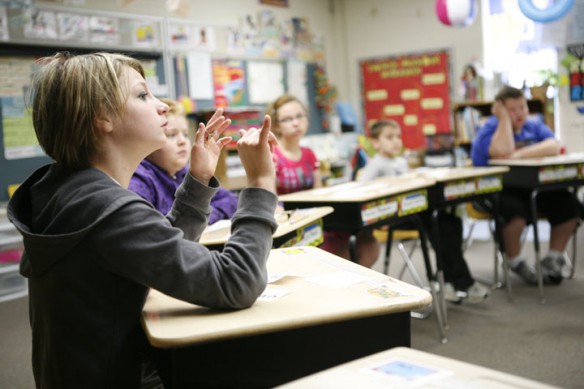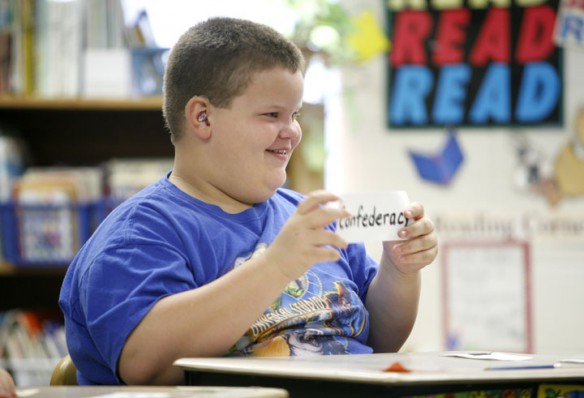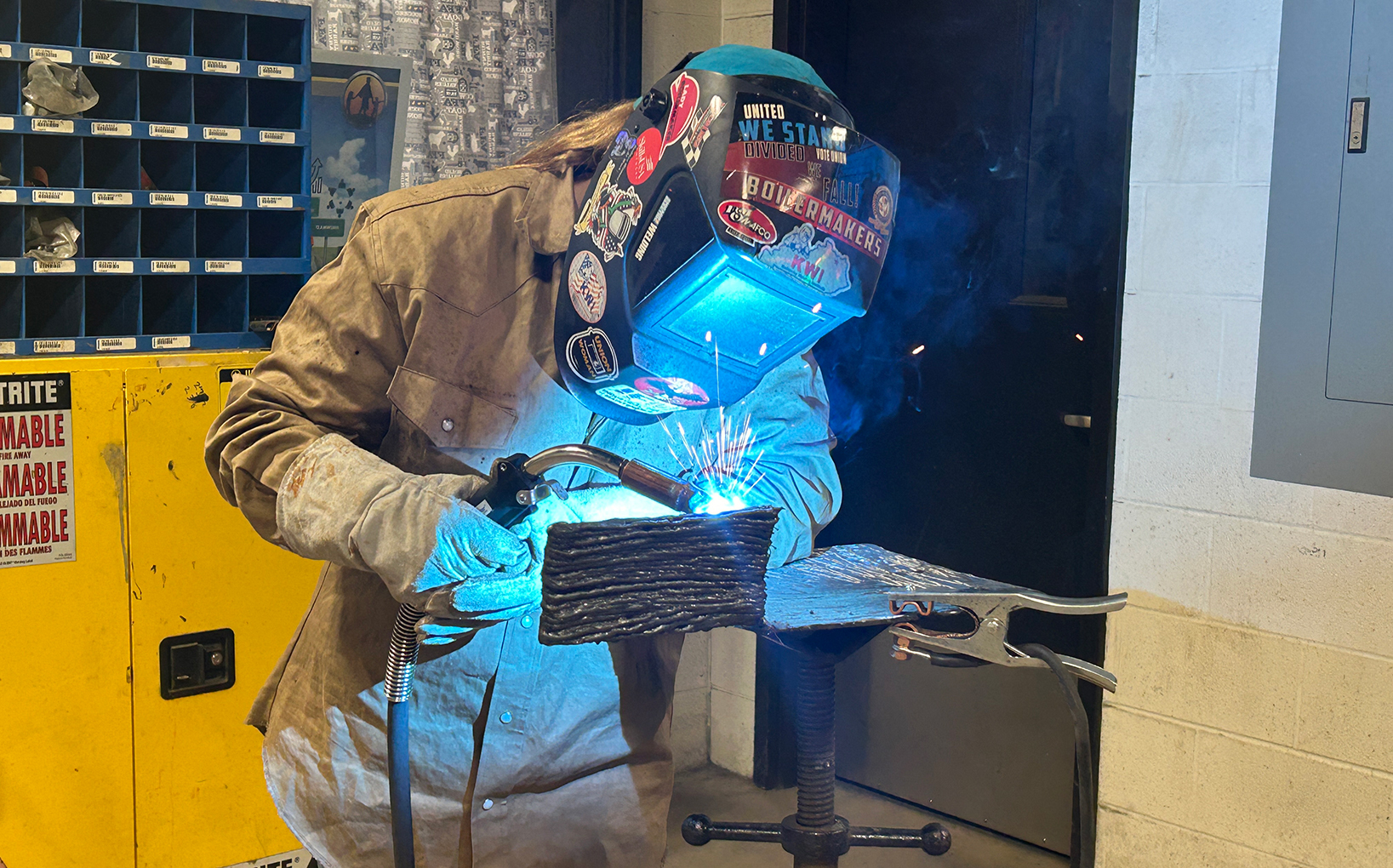
Fifth-grade student Parrie Kay Reed talks about her vocabulary term “border states” while her classmates listen during Karen Schulz’s 5th-grade class at the Kentucky School for the Deaf. They were learning about the Civil War. Photo by Amy Wallot, April 17, 2012
By Susan Riddell
Cathy White is formerly a Kentucky Department of Education (KDE) specialist for students with special needs and an expert in issues related to deafness.
As the mother of a deaf child who doesn’t use his voice to communicate, White was recently looking over a list of the speaking and listening standards included in the Kentucky Core Academic Standards (see box).
Each time she read one off, she had the same reply: “There’s no reason a deaf or blind student can’t do this.”
That’s the message echoed by many stakeholders at KDE and Kentucky School for the Deaf (KSD) and Kentucky School for the Blind (KSB).
“The speaking and listening standards are about communication, and students who don’t use their voices to communicate have multiple ways to communicate nonetheless,” said White, branch manager of Teacher and Leader Effectiveness in the Office of Next-Generation Learners.
“The speaking part is about how you communicate ideas in multiple ways for multiple audiences,” White added. “Even non-verbal students can communicate effectively, and that’s what the standards ask students to do.”
Karen Schulz teaches language arts, writing and social studies for grades 4-5 at KSD. She said teachers there know they are being held accountable for teaching all the new standards from Senate Bill 1, and that keeps them focused in instruction.
“We are taking the speaking and listening standards as is, knowing that spoken and listening standards for the majority of our students are met through receptive and expressive American Sign Language (ASL), not through spoken and the listening of English,” Schulz said.
Susan Hankins, who teaches high school grades at KSB, said the majority of her students do not have speech or hearing impairments, so her instruction in those areas are like they would be for traditional high school students who don’t have visual impairments.
“My personal philosophy is that high school students need rich and frequent opportunities to use speaking and listening skills every day,” Hankins said. “Through discussion of literature, book sharing and a multitude of other activities, they are given the opportunity to use these skills.”
Hankins added that the speaking and listening are important because of the self-expression they instill in students.
“They give them opportunities to voice their opinions, substantiate these opinions with supportive evidence and listen to and develop their values further as they listen to others,” she said.
Denise Bailey, with KDE’s Division of Learning Services, said that hearing- and vision-impaired students – and not just the ones at KSD and KSB – have access to modifications and accommodations through their Individual Education Programs (IEPs). Some of these include Braille, technology- and computer-based programs and other digital media and texts.
“Lessons can be modified by teachers to deliver the content but address individual needs to ensure success in the classroom and understanding of the Common Core State Standards of Listening and Speaking,” Bailey said. “It is essential that these students develop communication skills within these strands and that they are given the same opportunities as any other students within Kentucky.”
Schulz said the IEPs drive instruction at KSD.
“We still have to be ‘regular curriculum’ teachers, as well,” she said. “We have worked on curriculum alignment of all the new English/language arts (ELA) standards including speaking and listening and have highlighted those areas of speaking and listening that are most important for IEP development.”
Bailey added that teachers “need to be aware of the specially designed instruction and the supplementary aids and services listed in the student’s IEP,” she said.
“When working with students who are deaf or students who are visually impaired, it is very important when considering Specially Designed Instruction and Supplementary Aids and Services to address non-verbal communication,” Bailey added. “Within the speaking and listening standards there are three specific standards where additional consideration to the students’ Specially Designed Instruction and Supplementary Aids and Services would be necessary.”

Ethan Johnson listens for his vocabulary words to appear in a Brain Pop video about the Civil War during Karen Schulz’s 5th-grade class the Kentucky School for the Deaf. Photo by Amy Wallot, April 17, 2012
Those are standards 3, 5 and 6 dealing with speaker’s point of view; making strategic use of digital media and visual displays; and adapting speech to a variety of contexts and communicative tasks
Resources dealing with hearing- and vision-impaired students and these standards can help teachers guide students toward mastering them.
White recommends DynaVox and an app called Proloquo2go.
“Teacher resources include digital media and texts, collaboration among colleagues and the Continuous Instructional Improvement Technology System (CIITS) program, which offers lesson assistance and examples,” Bailey said. “As teachers across Kentucky teach lessons and share their expertise with others, the resources will become more abundant.”
“I’m familiar with CIITS, and I believe that it will become a valuable resource place for teachers to seek resources about the common core standards and all kinds of curriculum resources beginning now and in the future,” Hankins said.
Staff members at KDE are constantly looking at areas of concern teachers have regarding the implementation of the standards, and teachers can expect to be updated through leadership networks and other outlets.
“Often, there’s a barrier to the standards for many students be they deaf, blind, dyslexic, autistic or have an emotional behavior issue,” White said. “It’s incumbent on teachers to understand what each standard means. We as teachers have to understand not only the barriers, but how to deal with the barriers. Do we provide an interpreter or test orally for a dyslexic student?
“The standards stay the same,” White added. “What changes is the mode and method of instruction. We don’t lower or change the expectation. We change the level of support so that the child can meet that standard.”
MORE INFO …
Denise Bailey, denise.bailey@education.ky.gov, (502) 564-4970, ext. 4101



Leave A Comment